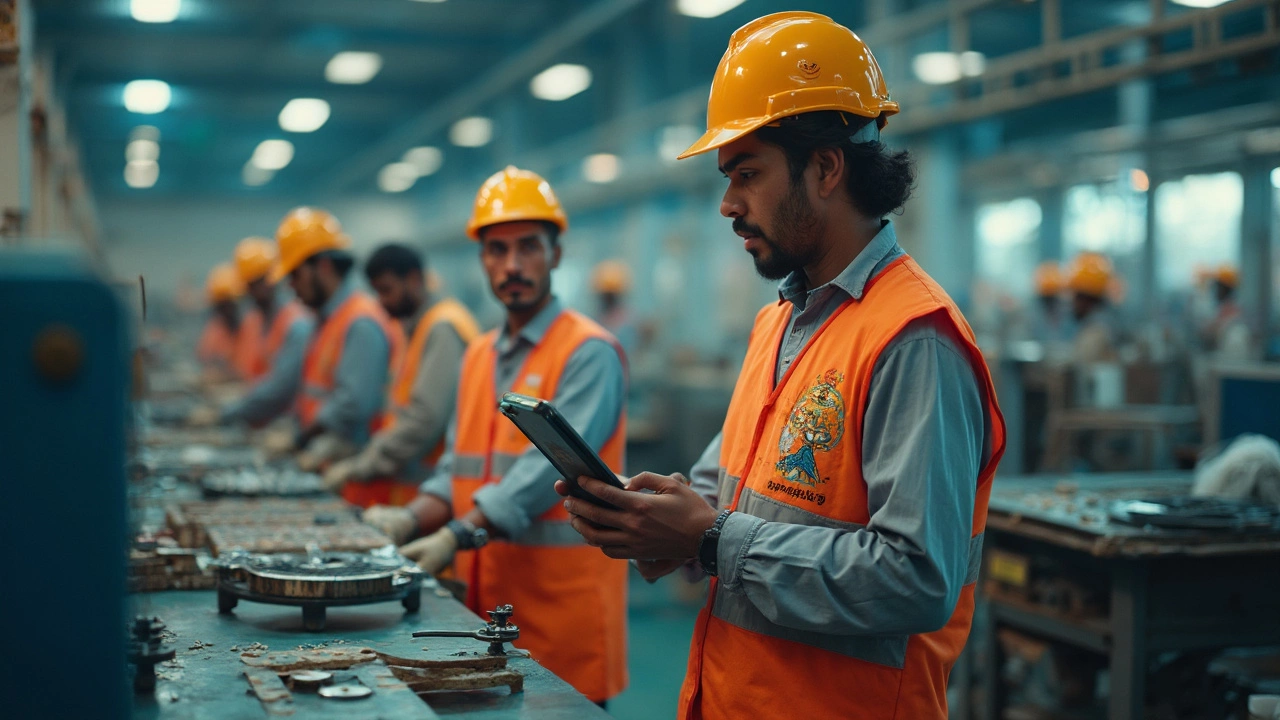Ask ten people what a manufacturer is, and you’ll probably get ten wildly different answers. Some imagine sprawling factories pumping out cars on assembly lines. Others think of a local bakery mixing dough for bread. But is every producer a manufacturer? This question stirs up more debate than you’d expect in boardrooms, courts, and even international trade policies. When you really peel back the layers, the answer isn’t as clear-cut as you might think.
The Core of Manufacturing: Breaking Down the Definition
The word "manufacturer" gets thrown around a lot, but there's real heft behind what qualifies a business for this title. At its heart, manufacturing is about transforming raw materials into new, tangible products, often at scale. But there’s nuance here—a furniture maker starting with solid wood isn’t the same as a reseller assembling flat-pack kits bought from abroad. The distinction? Transformation. The classic manufacturer actually changes the state, composition, or character of a material or component. For example, carmakers combine steel, glass, and rubber to create a wholly new vehicle. That’s manufacturing. A distributor just moving finished goods from point A to B is not.
The U.S. Census Bureau puts it succinctly: a manufacturer is an establishment "engaged in the mechanical, physical, or chemical transformation of materials, substances, or components into new products." It’s not just about putting things together—it’s that act of transformation. The International Standard Industrial Classification (ISIC) echoes this, emphasizing systematic industrial production processes. These definitions matter. In 2022, factories in the U.S. accounted for $2.60 trillion in economic output, according to the Bureau of Economic Analysis—making up about 12% of the nation's GDP. But not every factory qualifies. For example, a business placing its own label on other firms’ products doesn’t count as a manufacturer by Census standards, even if the end product looks unique.
This has real-world implications. Want to get government contracts or tax breaks aimed at manufacturers? Authorities look closely at whether your business meets these specific criteria. As a tip, if your business claims the manufacturing label, document the transformation process you control. Photo evidence, process charts, or even detailed SOPs (standard operating procedures) can help keep you off regulators’ radar—or get you benefits you’re eligible for.
And manufacturing stretches beyond just big factories. Think about contract manufacturers who produce goods under another company’s brand but do the actual transformation themselves. Even makers who focus on small-scale batch production or highly custom products like machine parts fall into the manufacturing bucket when they’re actually changing raw inputs into something new.
Creative industries sometimes muddy the waters. Is a 3D printing studio manufacturing custom trophies, or just prototyping them? Most current legal frameworks consider them manufacturers if they’re creating the final product for sale. The key is who controls the process and whether a fundamental transformation occurs.
This table helps clarify typical activities and whether they usually qualify as manufacturing:
| Activity | Qualifies as Manufacturing? | Why? |
|---|---|---|
| Assembling components from different suppliers into a new device | Yes | New product made by transforming parts |
| Installing hardware on customer premises | No | No transformation of inputs involved |
| Printing labels on finished products | No | Doesn’t change nature of the product |
| Baking cakes from raw ingredients to sell | Yes | Raw inputs transformed into new, edible items |
| Replicating CDs for artists from supplied digital files | Yes | Creates new, tangible product from digital input |

From Cottage Industry to Modern Megafactories: Types of Manufacturers
When you picture a manufacturer, what comes to mind—a mom-and-pop workshop, or tech giants with robots the size of small cars? The thing is, both count. The world of manufacturing covers a huge range of business models, all tied together by that key act of transformation.
First, you've got the classic mass producers. Think General Motors or Foxconn. These companies have assembly lines, standardized processes, and produce thousands (or millions) of identical units every year. Their size lets them squeeze costs and work on epic scale—Foxconn, for instance, employs over 700,000 people worldwide to build devices for brands like Apple and Sony.
But then there are contract manufacturers. They don’t sell under their own name, but they do the hard work of turning raw materials into finished goods for another company. Take Flex or Jabil; these giants make everything from circuit boards to finished gadgets that big brands re-badge. As long as the actual process of making—transforming one thing into another—happens under their roof or control, that’s manufacturing.
Custom or craft manufacturers shouldn’t get lost in the shuffle. A high-end bicycle frame builder producing 50 frames per year out of carbon fiber still qualifies as a manufacturer, even though they’re not chasing volume. In fact, some of the world’s most respected brands started as bespoke shops, then scaled up. What matters is the control over how a unique, physical product gets made.
The lines can blur with businesses like bakeries or microbreweries. The law usually sides with *manufacturing* if they’re transforming ingredients from scratch, not just heating up frozen goods. There’s also a boom in additive manufacturing (3D printing), which has opened the door for designers, artists, and engineers to join the ranks of manufacturers, even when running small studios.
If you’re trying to figure out where your own operation fits, ask a few simple questions:
- Do you turn raw materials into something else?
- Is your process repeatable and under your control?
- Are you selling the transformed product (not just the materials or a service)?
Answer "yes" to these, and you’re probably a manufacturer—no matter the scale. This definition means that even startups making limited runs of tech hardware on rented equipment can call themselves manufacturers, as long as they meet the transformation and control tests.
Laws and trade deals love to tinker with these lines. For instance, under NAFTA's old rules, just sticking labels on goods didn’t count, but assembling auto parts into a working car did. Why? Because transformation—again, bringing something new into being—is what manufacturing is all about. Next time you see a laptop, a mug, or a sneaker, remember: the label doesn’t matter as much as the process behind it.

Why the Definition of Manufacturer Matters
So why is everyone obsessed with what qualifies as a manufacturer? Because it’s not just a word—it comes with real-world perks and legal responsibilities. Specific tax breaks, special loans, and export privileges often only apply to companies officially recognized as manufacturers. That can mean the difference between a booming business and one stuck on the sidelines.
Take the U.S. “Section 199” tax deduction—this was just for manufacturers and was worth billions in total savings before it sunset in 2017. Companies spent serious cash with lawyers to prove they were eligible. The same logic holds for customs rules: tariffs may hit importers of finished goods, but if you do local final assembly or add enough value by transforming components, regulators might cut you a break. In countries like India or Germany, “manufacturer” status can also boost your access to subsidies or even amount to prestige—being an industrial employer still carries weight.
Let’s not ignore the flip side. Manufacturers face extra layers of regulation, from labor laws to environmental standards that distributors simply don’t. You need to track origin of materials, report chemical usage, and sometimes meet detailed workplace safety standards. Ignoring the difference can land your business in hot water—like that outdoor gear company in Oregon that lost millions in incentives after auditors decided they were simply repackaging, not making anything new.
Consumers care, too. Labels like “Made in the USA” or “Crafted by Hand” appeal to shoppers, but those phrases only legally apply if you meet strict manufacturing criteria. California’s labeling law, for instance, requires that virtually all significant transformation happen in-state before you slap a “California Made” sticker on a surfboard or organic soap. If you’re hoping to build your brand around “local” or “handmade,” make sure you’re actually transforming raw or base materials—not just reselling finished items with some stickers or packaging tweaks.
The future is only getting blurrier, thanks to automation, 3D printing, and AI-driven production. Regulations are racing to keep up, deciding whether software-based transformation (like using code to alter designs before printing objects) counts as manufacturing. For now, most agencies still fall back on physical transformation as the gold standard. So if your business is eyeing any government contracts or incentives tied to manufacturing, carefully document not just what you sell, but how it comes to exist.
Here’s a helpful tip: If you’re unsure whether you qualify, check the U.S. Census Bureau’s North American Industry Classification System (NAICS) codes. The 31-33 range covers most manufacturing subcategories, from food to fabricated metal. Having the right code can support your case for tax credits or grants—and help avoid unwanted audits.
Manufacturing will keep evolving—and so will the rules. But now that you know what really goes into earning that title, you can cut through the marketing fluff and legalese. If you want to call yourself a manufacturer, remember: It’s about transformation, control, and the real creation of something new. No matter if your factory is a city block or a converted garage, substance always beats style.
